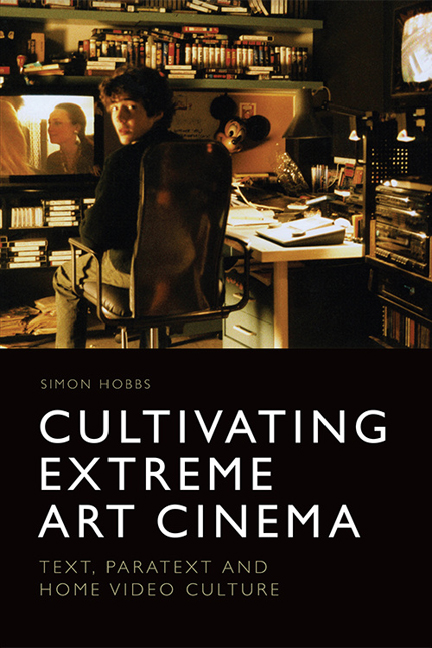Book contents
- Frontmatter
- Contents
- List of Figures
- Acknowledgements
- 1 Introduction
- 2 Art and Exploitation: Crossover, Slippage and Fluidity
- 3 Early Extremity on DVD: History, Precursors and Exploitation Auteurs
- 4 Weekend and Cannibal Holocaust: Art, Ballyhoo and Remediation
- 5 Salò, Or the 120 Days of Sodom and Ilsa, the Wicked Warden: Fascism, Pornography and Disgust
- 6 Contemporary Extremity on DVD: Trends, Hard-core and Geographic Mobility
- 7 Michael Haneke: Glaciation, Legitimacy and Transgression
- 8 Lars von Trier: Provocation, Condemnation and Confrontation
- 9 Conclusion
- Bibliography
- Index
6 - Contemporary Extremity on DVD: Trends, Hard-core and Geographic Mobility
Published online by Cambridge University Press: 28 April 2021
- Frontmatter
- Contents
- List of Figures
- Acknowledgements
- 1 Introduction
- 2 Art and Exploitation: Crossover, Slippage and Fluidity
- 3 Early Extremity on DVD: History, Precursors and Exploitation Auteurs
- 4 Weekend and Cannibal Holocaust: Art, Ballyhoo and Remediation
- 5 Salò, Or the 120 Days of Sodom and Ilsa, the Wicked Warden: Fascism, Pornography and Disgust
- 6 Contemporary Extremity on DVD: Trends, Hard-core and Geographic Mobility
- 7 Michael Haneke: Glaciation, Legitimacy and Transgression
- 8 Lars von Trier: Provocation, Condemnation and Confrontation
- 9 Conclusion
- Bibliography
- Index
Summary
Using the areas of focus established in Chapter 3, I will continue to chart the paratextuality of extreme art cinema throughout this chapter, paying particular attention to moments of hybridisation, borrowing and remediation. The chapter will start by briefly evaluating the specific cultural and cinematic changes which led to a lack of extreme art film production in the 1980s, before charting its resurgence in the 1990s and 2000s. During the latter, I will undertake paratextual analysis of key French extremity narratives, before assessing the differing techniques used in the distribution of other forms of European extremity. Thereafter the chapter will examine the changing nature of exploitation cinema, evaluating how the increasing refinement of the horror genre eventually led to the re-emergence of an excessive European horror product. These films sit on the margins of the extreme art film tradition, yet their paratextuality offers interesting points of insight and affects the way transgressive art films are understood by audiences. Once more, my aim here is not to provide an extensive historical survey. Rather, I seek to offer a snapshot of important shifts, films, directors and paratexts in order to provide a contextual framework for the case studies that follow.
Contemporary Extreme Art Cinema: ‘New French Extremity’ and Beyond
Market forces and changes in the industry are fundamental to understanding extreme art film. The fall of the Berlin Wall meant art cinema operated for the first time within a global film market (Galt 2006: 6), creating a new economic culture governed by the pressures of globalisation. These developments allowed Hollywood to find audiences within a larger number of territories (Chaudhuri 2005: 14), forcing art cinema to compete on a global stage. Changes to production models in Italy, which had previously been vital to the progression of extreme art film due to the films of Pier Paolo Pasolini, Bernardo Bertolucci, Dario Argento, Ruggero Deodato and Lucio Fulci, are illustrative of these larger shifts. Following the deregulation of television, the Italian industry was struggling to find an audience (Wood 2005: 29) and responded by concentrating national production on more mainstream-friendly features such as Cinema Paradiso (Tornatore 1988) and Life is Beautiful (Benigni 1997) (Brunetta 2005: 299).
- Type
- Chapter
- Information
- Cultivating Extreme Art CinemaText, Paratext and Home Video Culture, pp. 114 - 138Publisher: Edinburgh University PressPrint publication year: 2018



